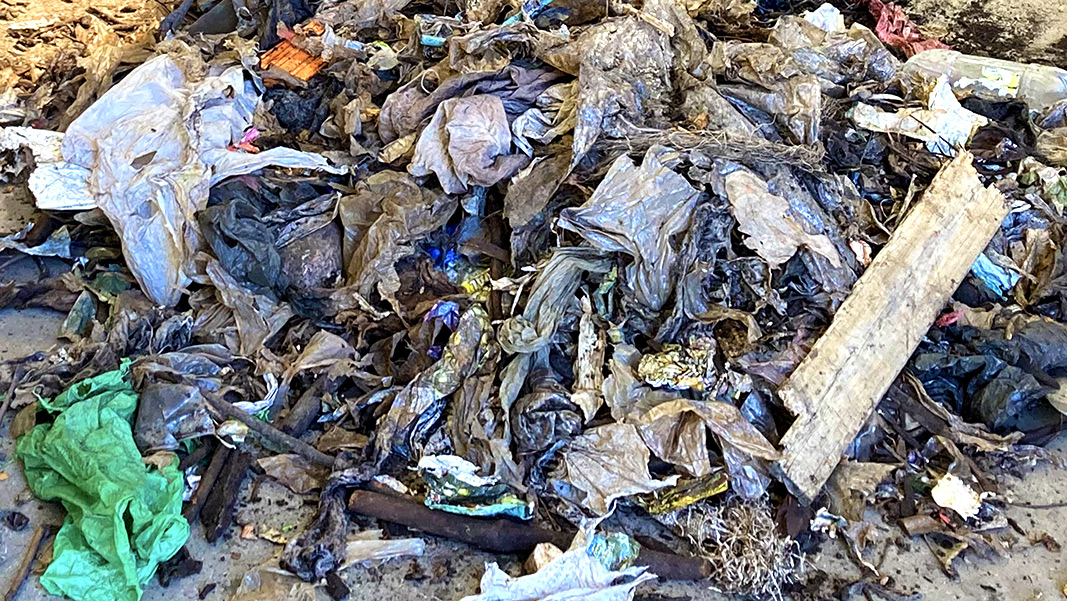Top: One of the first tasks to be completed was a baseline audit of the contamination in the raw feedstock (above).
Andy Kosek and Craig Coker
Creekside Soils (Creekside) is an enterprise department of the City of Hutchinson, Minnesota. It was created to develop and operate a composting facility handling yard trimmings and source separated organic materials (SSOM), most of which are food wastes and packaging. The program is standard offer, meaning that all 4,000+ Hutchinson households can put their SSOM (both food and yard trimmings) into their green bin for weekly curbside collection. In addition, both landscaping and land-clearing debris are dropped off by residents and contractors. In FY2021, Creekside Soils processed 6,796 tons of yard trimmings (including 3,787 tons/year from the City of St. Cloud) and 1,494.5 tons of SSOM.
Creekside has two composting facilities on one site. Yard trimmings are composted in open-air turned windrows while SSOM is composted in an in-vessel system purchased in 2001. In 2020, the authors began a project to evaluate alternatives to the in-vessel containerized composting system used to compost the SSOM, insofar as the containers were 20+ years old and in need of some repair. The decision was made to replace the containers with a compost-covered aerated static pile system, a project that is currently in permitting with the Minnesota Pollution Control Agency (MPCA).
While Creekside sells its yard trimmings compost in both bags and bulk, the SSOM compost is currently not being sold but rather used by other City departments. This is due to high levels of contamination from non-compostables, which Creekside is unable to screen out of the finished SSOM product because of their small size. The contaminants include glass, pens, straws, shards of plastics, etc.
In addition, curbside bin set out rates in the SSOM program have languished in the 25% to 55% range for many years, indicating both lack of program awareness and household apathy. The poor participation and set out rates are costing the City of Hutchinson about $180,000/year because the City pays for service to all households whether carts of SSOM are set out or not. (The budgeted amount for collection is 2023 is approximately $305,000.) Therefore, an increase in the curbside bin set out rate for SSOM diversion results in saving money as there is no cost to the City if West Central Sanitation — the private contractor collecting the SSOM — delivers the material to CreekSide.
However, if households throw the SSOM into the trash, it costs the City $63.57/ton to landfill the “lost” SSOM. (Hutchinson does not have a Pay-as-You-Throw solid waste fee system.) A 20% increase in SSOM pickups from the historic average of 42.9% to 62.9% could result in a savings of more than $46,000 annually. Reducing the contamination percentage in the SSOM also will save the City of Hutchinson money as CreekSide Soils is forced to landfill an average of 227.5 tons/year of contaminants removed in the screening system at an annual cost of about $16,057 (freight and tip fee).
The SSOM composting process starts with an average of 21 days in the aerated vessels. Next, the vessels are dumped onto a concrete pad and formed into windrows, which are turned using a windrow turner until maturity. Total length of the windrow phase varies by season and can be anywhere between four to six months. Finished SSOM compost is screened using a trommel two to three times per year. Screened overs, or rejects, are landfilled.
Raw Feedstock Audit
In November 2021, the MPCA issued a Request for Proposals for the Greater Minnesota Recycling and Composting Grant FY22, which stated, “These grant funds will help reduce the amount of recyclable materials entering landfills by helping communities establish best practices to improve local reuse, recycling, or composting program efficiency and effectiveness.” The authors submitted a grant proposal to conduct a “Compost It Right!” campaign, which will involve a well-crafted public outreach and education campaign to raise awareness of the program and the importance of good source separation practices, increase the amount of SSOM diverted to CreekSide, and improve feedstock quality so that the SSOM compost can become as popular as its yard trimmings compost. For the public outreach program, CreekSide partnered with Amplify for Change, a woman-owned small business with over 25 years’ experience in behavior change and social impact. CreekSide was notified of the grant award by MPCA in May 2022.
One of the first tasks to be completed was a baseline audit of the contamination problem in the raw feedstock. CreekSide management also wanted to understand how much contamination was ending up in the screened overs, which, visually, was so bad the overs had to be landfilled. West Central Sanitation runs the SSOM collection route five days per week using an automated side loader compactor truck. Typically, one load per day is tipped at Creekside, however, that one load can vary in tonnage from season to season — ranging from about 3 tons in winter months to up to 14 tons during the spring, summer and fall. During the peak fall leaf season, there may be two truck loads a day for a short window, e.g., one to two weeks. The goal was to perform the load audits mid-spring, when yard trimmings are starting to be collected but before they dominate the SSOM loads tipped.
The methodology created for the baseline raw feedstock audit included:
- West Central Sanitation unloads truck with SSOM on the floor of the tipping building. Get the weight of each incoming load from the scale house.
- As the truck unloads, take digital photographs of any obvious contamination. As CreekSide does not grind the SSOM before composting, larger pieces of potentially compostable material may be considered contamination (e.g., the folded green cardboard box in the right-hand photo in Figure 1).
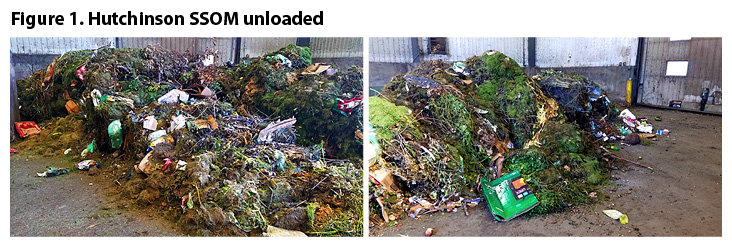
- During visual inspection of the tipped load, pick out any obvious contamination and account for it within the audited weights.
- Upon completion of visual inspection, use a wheel loader or skid steer loader to homogenize the tipped load.
- Using the skid steer loader, separate out two randomly selected full buckets of SSOM from the pile and move them over to the audit area; record the weights of each bucket.
- Weigh each empty container to record its tare, or empty weight.
- Manually separate the contents of the two skid-steer loaders into the following components and place them separately into the labeled containers): Hard plastic (e.g. HDPE, PP, PET); Film plastic; Metal (both aluminum and steel); Glass; Rock/brick; Large pieces of wood (e.g. thicker than your wrist); Large pieces of cardboard; Anything clearly not compostable (e.g. yard tools, auto parts, trash, etc.); Yard trimmings; and Food wastes.
- Weigh each container at the end of each day and record the results.
- Repeat steps 1 – 4 every day for two work weeks (10 days total).
- At the end of the audit period prepare a table that lists weight of each load received over the 10-day audit period and the net weights of each container of contaminants (net weight = full weight – empty weight).
The feedstock audit was performed June 8 – June 17, 2022 and the results are reported in Table 1.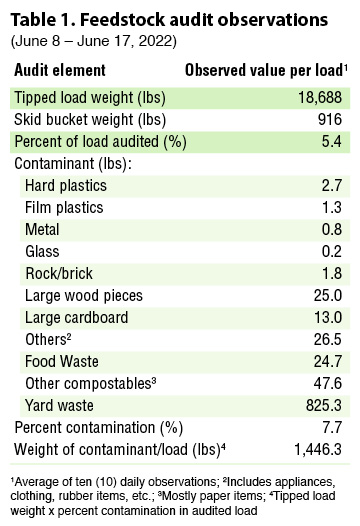
The “others” category includes appliances, clothing, rubber items, etc. The “Other compostables” category was mostly paper items. Some of the contaminants from the raw feedstock audit are shown in Figure 2 and included a plastic cooling fan, blue jeans in a plastic bag, metal grating, painted wood, and Christmas lights.
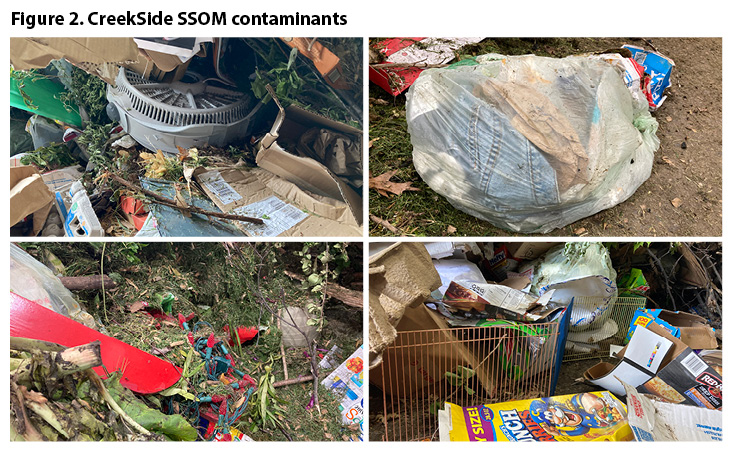 Overs Audit
Overs Audit
For the screened overs contamination audit, the following protocol was developed:
- At the completion of the screening event, take digital photographs of the overs generated.
- Using a skid steer loader, separate two randomly selected full buckets of SSOM from the overs pile, weigh and record each full bucket weight and move them to the audit area.
- Perform an audit on the overs materials to determine the material make-up, manually separating and placing the following components into two separately labeled containers. The first container is for un-composted organic material: Green wood waste (smaller than thickness of wrist); Large pieces of cardboard; “Balls” of wet, finished compost. The second container is for contaminants, including Film plastic; Metal (both aluminum and steel); Glass (if not shattered and is practical); Rock/brick; Green wood waste (larger than thickness of wrist); Dimensional lumber; Anything clearly not compostable.
- At the end of the audit, weigh the container holding contaminants and record the weight; empty the container and record the container’s empty weight.
- Prepare a table listing the weights. The audit weights will be weighed against the net tonnage of overs disposed of at the landfill for that specific screening event soon after the screening event.
- This audit will take place once per year nearest to the raw SSOM feedstock audit date(s) as practical, using two skid loader buckets per audit.
Figure 3 shows the screened SSOM compost and the SSOM overs as they come off the discharge belt of the trommel. The balls of wet clumped compost found in the overs are apparently due to plastic films in the materials acting as a shield to restrict air flow through a windrow during curing — essentially creating a greenhouse effect within the windrow. Moisture in the materials isn’t allowed to evaporate out of the windrow via the “chimney” effect but is rather trapped and ultimately is retained by the compost as it matures. The amount of plastics in the overs does not make it worthwhile to recapture these “balls” by blending the overs materials back into process with the fresh, raw feedstocks received.
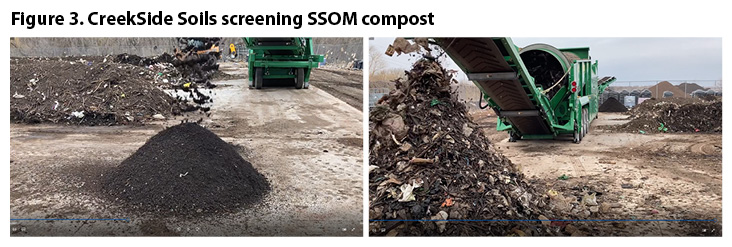 The overs audit took place at the same time as the feedstock audit. Two 300-lb skid steer bucket loads were sorted and CreekSide staff found a contamination rate of 23.1% (138.6 lbs. of contaminants and 461.4 lbs. of woody organics). Figure 4 illustrates the contaminants removed.
The overs audit took place at the same time as the feedstock audit. Two 300-lb skid steer bucket loads were sorted and CreekSide staff found a contamination rate of 23.1% (138.6 lbs. of contaminants and 461.4 lbs. of woody organics). Figure 4 illustrates the contaminants removed.
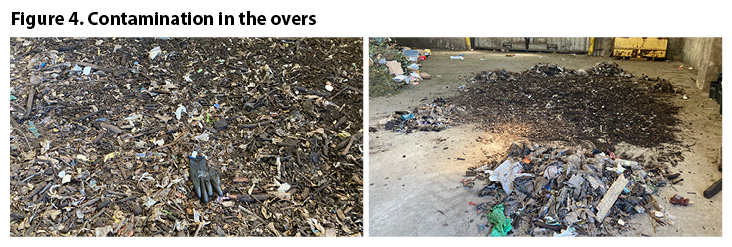 Amplify’s outreach and education program will roll out in the fourth quarter of 2022 and run for two years. CreekSide will repeat these audits again in April 2023 and April 2024 to see if measurable contamination improvement is seen.
Amplify’s outreach and education program will roll out in the fourth quarter of 2022 and run for two years. CreekSide will repeat these audits again in April 2023 and April 2024 to see if measurable contamination improvement is seen.
Andy Kosek is the Operations Manager at the City of Hutchinson’s CreekSide Soils. He can be reached at AKosek@creeksidesoils.com. Craig Coker is a Senior Editor at BioCycle and CEO of Coker Composting & Consulting near Roanoke, VA. He can be reached at ccoker@cokercompost.com


